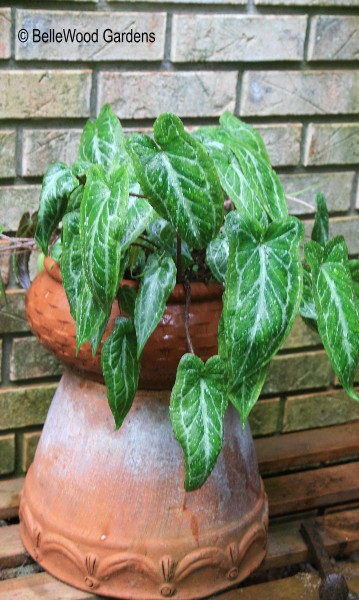
Wednesday, 3 June 2009
Pinellia cordata
I'm very fond of aroids, plants in the Family Araceae. What's that? you ask. Everything from houseplants such as philodendron and dieffenbachia to native plants like Arisaema triphyllum, Jack in the pulpit, hardy exotics such as Arum and Arisarum, mouse plant, and popular tropicals such as Caladium, Calla, and Colocasia, elephant ear. For one thing, plants in this family all have rhizomes or tubers, and I'm especially fond of suchlike plants with the underground structures we casually lump together under the common name of bulb. (Geophyte is a much more impressive word that collects bulb, corm, tuber, rhizome under one term.) Aroids are laced with crystals of calcium oxalate, also known as oxalic acid. These crystals or needle-like raphides are nasty to ingest. In fact, that's how Dieffenbachia acquired the common name of dumb cane. While it looks somewhat like sugar cane, if someone is fooled into chewing on dumb cane their tongue and mouth will swell so much that for a time they cannot speak. It also means that various garden vermin such as voles, rabbits, woodchucks, and deer do not dine on plants with membership in this plant family.
Pinellia is one of the more than a hundred genera included in Family Araceae. Native to China, Korea, and Japan, Pinellia includes 6 genera, and most of them are outright dangerous thugs that happily infest a garden. Oh, they're cute alright, but will move themselves around in profligate manner. If someone offers you any of these little green dragons - Pinellia pedatisecta, with its attractive 7 to 11 segmented leaves, or P. ternata, or P. tripartita, have excuses prepared in advance as to why you're saying thanks, but no thanks. They thrive in the Southeastern United States, they're hardy to zone 4, such as Ithaca, New York.
And then there is Pinellia cordata.

Simple leaf, heart-shaped base, purple-red below and delightfully marked
with silver on the dark green upper side of the leaf. See the notch where leaf
meets petiole? Later on a small tuberlet (or whatever is the proper name)
will form, mature, and fall off. Last year they must have fallen into the gravel
that surfaces the display bed between front walk and garage wall. Surprise!
They obviously wintered over and decided to make an appearance this Spring.

Understand that the picture was taken rather close-up so the gravel looks like boulders.
I just slipped outdoors between the raindrops to measure the infant pinellia leaves.
Smaller leaves are 1.25 cm from stem notch to tip, up to 3.5 cm for largest ones.
Some might have shown up last year but not all dozen or more now present.
I have not tried to grow this little green dragon in the garden. It is very easy in a pot:
Use a free draining potting mix with some compost or leaf mold added in.
Keep moist but not soggy during the growing season, in a shady site.
In autumn, move somewhere it gets quite cold but does not freeze.
Stop watering, and basically ignore until sometime in mid- to late April.
Scrape off the upper layer of soil and replace with fresh potting mix.
Water thoroughly, once, then wait for signs of life before watering again.
.
And why in a pot? Because, as Nihei-san who gave it to me wrote
"In pot it is easy to lift up to nose and enjoy the flowers sweet fragrance."